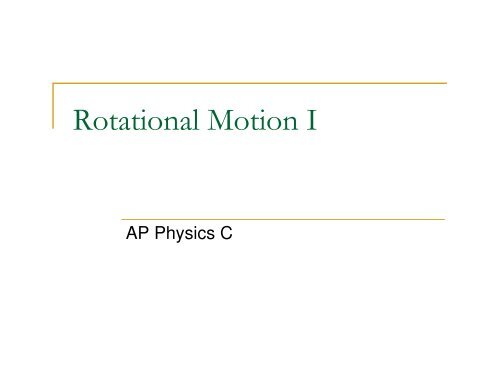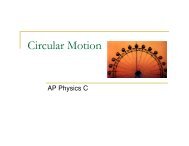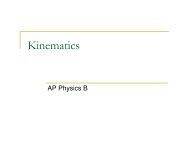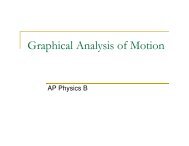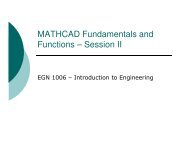Rotational Motion I
Rotational Motion I
Rotational Motion I
Create successful ePaper yourself
Turn your PDF publications into a flip-book with our unique Google optimized e-Paper software.
<strong>Rotational</strong> <strong>Motion</strong> I<br />
AP Physics C
The radian<br />
There are 2 types of pure unmixed motion:<br />
Translational - linear motion<br />
<strong>Rotational</strong> - motion involving a rotation or revolution around a<br />
fixed chosen axis( an axis which does not move).<br />
We need a system that defines BOTH types of motion working<br />
together on a system. <strong>Rotational</strong> quantities are usually defined<br />
with units involving a radian measure.<br />
If we take the radius of a circle and LAY IT<br />
DOWN on the circumference, it will create<br />
an angle whose arc length is equal to<br />
R.<br />
In other words, one radian angle is<br />
subtends an arc length ∆∆∆∆s equal to the<br />
radius of the circle (R)
The radian<br />
Half a radian would subtend an arc length equal to half the radius and 2<br />
radians would subtend an arc length equal to two times the radius.<br />
A general Radian Angle (∆θ) subtends an arc length (∆s) equal to R.<br />
The theta in this case represents ANGULAR DISPLACEMENT.
Angular Velocity<br />
∆x<br />
v = → translational<br />
velocity<br />
∆t<br />
∆θ<br />
ω = → rotational velocity<br />
∆t<br />
dx dθ<br />
v = , ω =<br />
dt dt<br />
NOTE:<br />
Translational motion tells you THREE THINGS<br />
• magnitude of the motion and the units<br />
• Axis the motion occurs on<br />
• direction on the given axis<br />
Since velocity is defined as the rate of<br />
change of displacement. ANGULAR<br />
VELOCITY is defined as the rate of<br />
change of ANGULAR DISPLACEMENT.<br />
1 revolution = 2π<br />
radians =<br />
o<br />
360<br />
Example: v =3i<br />
This tells us that the magnitude is 3 m/s, the axis is the "x" axis and<br />
the direction is in the "positive sense".
Translation vs. Rotation<br />
Translational motion tells you THREE<br />
THINGS<br />
• magnitude of the motion and the units<br />
• Axis the motion occurs on<br />
• direction on the given axis<br />
Example: v =3i<br />
This tells us that the magnitude is 3 m/s,<br />
the axis is the "x" axis and the direction is<br />
in the "positive sense".<br />
<strong>Rotational</strong> motion tells you THREE THINGS:<br />
• magnitude of the motion and the units<br />
• the PLANE in which the object rotates in<br />
• the directional sense ( counterclockwise or clockwise)<br />
Counterclockwise rotations are defined as having a<br />
direction of POSITVE K motion on the "z" axis
Rotation<br />
Example: Unscrewing a screw or bolt<br />
= 5 rad/sec k<br />
Clockwise rotations are defined as having a<br />
direction of NEGATIVE K motion on the "z"<br />
axis<br />
Example: Tightening a screw or bolt<br />
= -5 rad/sec k
Angular Acceleration<br />
∆v<br />
a = → translational<br />
acceleration<br />
∆t<br />
∆ω<br />
α = → rotational acceleration<br />
∆t<br />
dv dω<br />
a = , α =<br />
dt dt<br />
x<br />
v<br />
=<br />
=<br />
∫<br />
∫<br />
v dt,<br />
a dt,<br />
θ =<br />
ω =<br />
∫<br />
ω dt<br />
∫<br />
α dt<br />
Once again, following the same lines of<br />
logic. Since acceleration is defined as the<br />
rate of change of velocity. We can say the<br />
ANGULAR ACCELERATION is defined<br />
as the rate of change of the angular<br />
velocity.<br />
Also, we can say that the ANGULAR<br />
ACCELERATION is the TIME<br />
DERIVATIVE OF THE ANGULAR<br />
VELOCITY.<br />
All the rules for integration apply as<br />
well.
Combining motions –Tangential velocity<br />
First we take our equation for the radian<br />
measure and divide BOTH sides by a change in<br />
time.<br />
The left side is simply the equation for LINEAR<br />
velocity. BUT in this case the velocity is<br />
TANGENT to the circle (according to Newton's<br />
first law). Therefore we call it TANGENTIAL<br />
VELOCITY.<br />
Inspecting the right side we discover the formula<br />
for ANGULAR VELOCITY.<br />
Therefore, substituting the appropriate<br />
symbols we have a formula that relates<br />
Translational velocity to <strong>Rotational</strong><br />
velocity.
Tangential acceleration and rotational kinematics<br />
v<br />
t<br />
a<br />
t<br />
vt<br />
= rω<br />
→<br />
∆t<br />
= rα<br />
=<br />
rω<br />
∆t<br />
Using the same kind of mathematical<br />
reasoning we can also define Linear<br />
tangential acceleration.<br />
Inspecting each equation we discover<br />
that there is a DIRECT relationship<br />
between the Translational quantities<br />
and the <strong>Rotational</strong> quantities.<br />
We can therefore RE-WRITE each translational kinematic equation and<br />
turn it into a rotational kinematic equation.<br />
v<br />
x<br />
v<br />
2<br />
=<br />
=<br />
v<br />
=<br />
x<br />
o<br />
o<br />
v<br />
+<br />
→<br />
+ v + 1<br />
ot<br />
at<br />
2<br />
+ 2a∆x<br />
→<br />
2<br />
o<br />
at<br />
ω = ω + αt<br />
2<br />
o<br />
→<br />
2<br />
ω<br />
θ = θ + ω t +<br />
2<br />
= ω<br />
o<br />
o<br />
o<br />
+ 2α∆θ<br />
1 αt<br />
2<br />
2
Example<br />
A turntable capable of<br />
angularly accelerating at<br />
12 rad/s 2 needs to be<br />
given an initial angular<br />
velocity if it is to rotate<br />
through a net 400 radians<br />
in 6 seconds. What must<br />
its initial angular velocity<br />
be?<br />
α = 12 rad<br />
∆θ<br />
=<br />
t<br />
ω<br />
=<br />
o<br />
o<br />
6 s<br />
=<br />
2<br />
∆θ<br />
= ωo<br />
2t<br />
+ 1 αt<br />
2<br />
400 = ω ( 6)<br />
+ ( 0.<br />
5)(<br />
12)(<br />
6)<br />
ω<br />
=<br />
400rad<br />
?<br />
o<br />
/<br />
s<br />
2<br />
30.7 rad/s<br />
2
<strong>Rotational</strong> Kinetic Energy and Inertia<br />
Just like massive bodies tend<br />
to resist changes in their<br />
motion ( AKA - "Inertia") .<br />
Rotating bodies also tend<br />
to resist changes in their<br />
motion. We call this<br />
ROTATIONAL INERTIA.<br />
We can determine its<br />
expression by looking at<br />
Kinetic Energy.<br />
K<br />
K<br />
K<br />
K<br />
2<br />
= 1 mv , v<br />
2<br />
t<br />
2<br />
= 1 m(<br />
rω)<br />
2<br />
1 2 2<br />
= mr ω ,<br />
2<br />
1 2<br />
= Iω<br />
2<br />
rot<br />
= rω<br />
I<br />
=<br />
∑<br />
mr<br />
We now have an expression for the rotation of a<br />
mass in terms of the radius of rotation.<br />
We call this quantity the MOMENT OF INERTIA (I)<br />
with units kgm 2<br />
2
Moment of Inertia, I<br />
I<br />
=<br />
∑<br />
mr<br />
This is what we would see if m1 = m2.<br />
Suppose m1>m2.<br />
r1<br />
m1 m2<br />
r2<br />
2<br />
Consider 2 masses, m1 & m2,<br />
rigidly connected to a bar of<br />
negligible mass. The system<br />
rotates around its CM.<br />
m1 m2<br />
Since it is a rigid body, the have the SAME<br />
angular velocity, ω. The velocity of the center,<br />
v cm of mass is zero since it is rotating around it.<br />
We soon see that the TANGENTIAL SPEEDS<br />
are NOT EQUAL due to different radii.<br />
vt =<br />
rω
Moment of Inertia, I<br />
Since both masses are moving they have kinetic energy<br />
or rotational kinetic in this case.<br />
K = K + K<br />
K<br />
K<br />
K<br />
K<br />
=<br />
=<br />
=<br />
=<br />
1<br />
1<br />
2<br />
(<br />
∑<br />
i=<br />
1<br />
2<br />
1 2<br />
2<br />
m1v1<br />
+ 1 m2v2<br />
,<br />
2 2<br />
1 2 2<br />
m1(<br />
r 1<br />
1 ω ) + m<br />
2<br />
2<br />
1 2 2 2<br />
( m1r1<br />
+ m2r2<br />
) ω<br />
2<br />
N<br />
m<br />
i<br />
r<br />
2<br />
i<br />
2<br />
) ω<br />
→<br />
2<br />
K<br />
v<br />
t<br />
( r<br />
=<br />
2<br />
2<br />
= rω<br />
2<br />
ω )<br />
1<br />
2<br />
2<br />
Iω<br />
So this example clearly illustrates the idea behind the<br />
SUMMATION in the moment of inertia equation.<br />
r1<br />
m1 m2<br />
r2
Example<br />
E<br />
U<br />
mgh =<br />
v<br />
=<br />
mgh =<br />
gh =<br />
v<br />
before<br />
g<br />
=<br />
=<br />
=<br />
K<br />
Rω<br />
T<br />
1<br />
2<br />
6<br />
5<br />
E<br />
1<br />
2<br />
1<br />
2<br />
+ K<br />
v<br />
after<br />
I<br />
2<br />
gh<br />
mv<br />
+<br />
=<br />
2<br />
2<br />
+<br />
+<br />
1<br />
3<br />
1<br />
2<br />
sphere@<br />
cm<br />
mv<br />
R<br />
=<br />
2<br />
3<br />
1 ( 2<br />
2 3<br />
v<br />
2<br />
2<br />
Iω<br />
mR<br />
mR<br />
6 ( 9.<br />
8)(<br />
5)<br />
5<br />
A very common problem is to find the velocity of a ball<br />
rolling down an inclined plane. It is important to realize<br />
that you cannot work out this problem they way you<br />
used to. In the past, everything was SLIDING. Now the<br />
object is rolling and thus has MORE energy than<br />
normal. So let’s assume the ball is like a thin spherical<br />
shell and was released from a position 5 m above the<br />
ground. Calculate the velocity at the bottom of the<br />
incline.<br />
2<br />
2<br />
=<br />
v<br />
)(<br />
R<br />
2<br />
2<br />
)<br />
7.67 m/s<br />
E<br />
U<br />
mgh<br />
mgh<br />
gh<br />
v<br />
before<br />
g<br />
=<br />
=<br />
=<br />
=<br />
K<br />
T<br />
E<br />
= 1<br />
2<br />
= 1<br />
2<br />
1 v<br />
2<br />
after<br />
2<br />
mv<br />
mv<br />
2gh<br />
=<br />
2<br />
2<br />
If you HAD NOT<br />
included the<br />
rotational kinetic<br />
energy, you see the<br />
answer is very much<br />
different.<br />
2(<br />
9.<br />
8)(<br />
5)<br />
=<br />
9.<br />
90<br />
m / s
Example: Moment of Inertia, I<br />
I<br />
=<br />
∑<br />
mr<br />
2<br />
I<br />
I<br />
= ∑ mr<br />
=<br />
Let's use this equation to analyze<br />
the motion of a 4-m long bar with<br />
negligible mass and two equal<br />
masses(3-kg) on the end rotating<br />
around a specified axis.<br />
( 3)(<br />
2)<br />
2<br />
2<br />
=<br />
+<br />
mr<br />
2<br />
( 3)(<br />
2)<br />
+ mr<br />
2<br />
=<br />
2<br />
m1 m2<br />
EXAMPLE #1 -The moment of Inertia when they are rotating around the<br />
center of their rod.<br />
EXAMPLE #2-The moment if Inertia rotating at<br />
one end of the rod<br />
I<br />
I<br />
= ∑ mr<br />
=<br />
( 3)(<br />
0)<br />
2<br />
2<br />
=<br />
+<br />
mr<br />
2<br />
( 3)(<br />
4)<br />
+ mr<br />
2<br />
=<br />
24 kgm 2<br />
2<br />
48 kgm 2<br />
m1 m2
Example cont’<br />
Now let’s calculate the moment of Inertia rotating at a<br />
point 2 meters from one end of the rod.<br />
I<br />
I<br />
= ∑ mr<br />
=<br />
( 3)(<br />
2)<br />
2<br />
2<br />
=<br />
+<br />
mr<br />
2<br />
+<br />
( 3)(<br />
6)<br />
2<br />
mr<br />
=<br />
2<br />
120 kgm 2<br />
2m<br />
m1 m2<br />
As you can see, the FARTHER the axis of rotation is from the center of mass,<br />
the moment of inertia increases. We need an expression that will help us<br />
determine the moment of inertia when this situation arises.
Parallel Axis Theorem<br />
This theorem will allow us to calculate the moment of<br />
inertia of any rotating body around any axis,<br />
provided we know the moment of inertia about the<br />
center of mass.<br />
It basically states that the Moment of Inertia ( I p ) around any axis "P" is<br />
equal to the known moment of inertia (I cm ) about some center of mass plus<br />
M ( the total mass of the system) times the square of "d" ( the distance<br />
between the two parallel axes)<br />
Using the prior example let’s use the parallel axis theorem to calculate the<br />
moment of inertia when it is rotating around one end and 2m from a fixed<br />
axis.
Exam – Parallel Axis Theorem<br />
I<br />
I<br />
I<br />
I<br />
p<br />
p<br />
p<br />
p<br />
=<br />
=<br />
=<br />
=<br />
I<br />
cm<br />
+<br />
( 24)<br />
I<br />
cm<br />
+<br />
+<br />
( 24)<br />
Md<br />
2<br />
( 6)(<br />
2)<br />
+<br />
Md<br />
2<br />
2<br />
( 6)(<br />
4)<br />
=<br />
2<br />
=<br />
48 kgm 2<br />
120 kgm 2<br />
4m<br />
m1 m2<br />
d = 2m<br />
m1 m2<br />
(not drawn to scale)
Continuous Masses<br />
The earlier equation, I =Σmr 2 , worked fine for what is called<br />
POINT masses. But what about more continuous masses<br />
like disks, rods, or sphere where the mass is extended<br />
over a volume or area. In this case, calculus is needed.<br />
I<br />
∑<br />
2<br />
2<br />
= mr → I = r dm<br />
∫<br />
This suggests that we will<br />
take small discrete amounts<br />
of mass and add them up over<br />
a set of limits. Indeed, that is<br />
what we will do. Let’s look at a<br />
few example we “MIGHT”<br />
encounter. Consider a solid<br />
rod rotating about its CM.<br />
Will, I =Σmr 2 , be the equation<br />
for a rod?
The rod<br />
We begin by using the same technique used to<br />
derive the center of mass of a continuous body.<br />
I<br />
∑<br />
2<br />
2<br />
= mr → I = r dm<br />
M<br />
Macro → λ =<br />
L<br />
dm<br />
Micro → λ = =<br />
dx<br />
I<br />
I<br />
I<br />
=<br />
= λ<br />
=<br />
∫<br />
r<br />
∫<br />
M<br />
L<br />
2<br />
−L<br />
dm<br />
→<br />
∫<br />
dm<br />
dr<br />
∫<br />
dm = λdr<br />
( λ)<br />
dr<br />
3<br />
2<br />
2 M r<br />
r dr → | |<br />
2 L 3<br />
3<br />
3<br />
L 8 − L 8<br />
( − ) →<br />
3 3<br />
L<br />
L<br />
2<br />
−L<br />
2<br />
r<br />
2<br />
L 2<br />
−L<br />
2<br />
M<br />
L<br />
3<br />
L<br />
(<br />
24<br />
+<br />
3<br />
L<br />
)<br />
24<br />
=<br />
dr<br />
The CM acts as the origin in the<br />
case of determining the limits.<br />
Irod @cm<br />
=<br />
ML<br />
12<br />
2
Your turn<br />
What if the rod were rotating on one of its ENDS?<br />
I<br />
∑<br />
2<br />
2<br />
= mr → I = r dm<br />
M<br />
Macro → λ =<br />
L<br />
dm<br />
Micro → λ = =<br />
dx<br />
I<br />
I<br />
I<br />
=<br />
= λ<br />
=<br />
∫<br />
r<br />
∫<br />
M<br />
L<br />
2<br />
0<br />
L<br />
dm<br />
r<br />
2<br />
L<br />
(<br />
3<br />
3<br />
−<br />
dm<br />
dr<br />
→<br />
dr<br />
∫<br />
→<br />
0)<br />
0<br />
L<br />
∫<br />
=<br />
dm = λdr<br />
r<br />
2<br />
M<br />
L<br />
( λ)<br />
dr<br />
|<br />
r<br />
3<br />
3<br />
|<br />
L<br />
0<br />
Irod @end<br />
=<br />
ML<br />
3<br />
2<br />
dr<br />
As you can see you get<br />
a completely different<br />
expression depending<br />
on HOW the body is<br />
rotating.
The disk<br />
∫<br />
∑<br />
=<br />
→<br />
= dm<br />
r<br />
I<br />
mr<br />
I<br />
2<br />
2<br />
rdr<br />
dm<br />
dr<br />
or<br />
rdx<br />
dm<br />
dA<br />
dm<br />
Micro<br />
R<br />
M<br />
A<br />
M<br />
Macro<br />
π<br />
σ<br />
π<br />
σ<br />
π<br />
σ<br />
2<br />
)<br />
(<br />
2<br />
2<br />
=<br />
=<br />
=<br />
→<br />
=<br />
=<br />
→<br />
=<br />
−<br />
=<br />
→<br />
=<br />
→<br />
=<br />
∫<br />
∫<br />
∫<br />
)<br />
0<br />
4<br />
(<br />
2<br />
|<br />
4<br />
|<br />
2<br />
2<br />
)<br />
2<br />
(<br />
4<br />
2<br />
0<br />
4<br />
2<br />
0<br />
3<br />
0<br />
2<br />
2<br />
R<br />
R<br />
M<br />
I<br />
r<br />
R<br />
M<br />
dr<br />
r<br />
I<br />
dr<br />
r<br />
r<br />
dm<br />
r<br />
I<br />
R<br />
R<br />
R<br />
π<br />
π<br />
πσ<br />
π<br />
σ<br />
2<br />
2<br />
@<br />
MR<br />
I cm<br />
disk<br />
=<br />
R<br />
r<br />
dx<br />
dx<br />
2πr
The bottom line..<br />
Will you be asked to derive the moment of<br />
inertia of an object? Possibly! Fortunately,<br />
most of the time the moment of inertia is<br />
given within the free response question.<br />
Consult the file ( on the notes page) called<br />
Moments of Inertia to view common<br />
expressions for “I” for various shapes and<br />
rotational situations.


